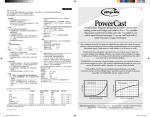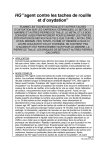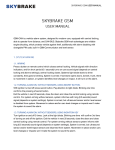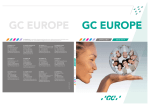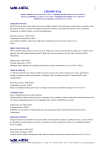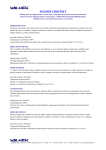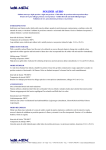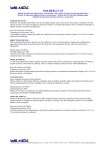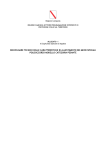Download Istruzioni d`uso Instructions for use Mode d`emploi - Nobil
Transcript
PVF ITALIANO Istruzioni d’uso ENGLISH Instructions for use français POWDER&LIQUID Mode d’emploi Str. Sr. Rocco, 28 - 14018 Villafranca d’Asti - ITALY - Tel. +39 0141 933811 - Fax +39 0141 943840 [email protected] - [email protected] - [email protected] - http://www.nobilmetal.it ITALIANO Istruzioni d’uso PVF powder&liquid RIVESTIMENTO UNIVERSALE DI PRECISIONE PER TUTTI I TIPI DI LEGHE E CERAMICHE PRESSABILI (integrali oppure su strutture in lega e/o ceramica) Superfici perfette, massima precisione e facile smuffolatura PREPARAZIONE 1. Se si utilizza un cilindro in metallo, è raccomandato inserire un liner (non inumidire il liner: potrebbe far aumentare l’espansione di presa) in fibra di 3 mm di spessore. 2. Spruzzare o pennellare un sottile film di agente riduttore di tensione sul modellato in cera, posizionare il cilindro sulla base di gomma e mettere immediatamente in rivestimento. Non lasciare asciugare il film e non usare assolutamente aria compressa per asciugare eventuali eccedenze. 3. Preparare il liquido come indicato nella tabella (utilizzare acqua distillata per diluire). 4. Pulire la tazza di miscelazione con acqua ed asciugare accuratamente. 5. Versare la misura di liquido e miscelare la relativa quantità di polvere spatolando a mano per 15 secondi sul vibratore. 6. Proseguire la miscelazione sotto vuoto a bassa velocità (300 giri/minuto) per 60 secondi. Tenere l’impasto sottovuoto per 15 secondi senza miscelare. 7. Procedere al riempimento del cilindro con bassa vibrazione arrestando il vibratore appena riempito il cilindro. Il cilindro dovrà essere posizionato in forno su una superficie con scanalature o leggermente inclinato per agevolare l’eliminazione della cera e/o dei materiali resinosi. Il cono di entrata deve essere sempre rivolto verso il basso. TECNICA RAPIDA 1. Lasciare indurire il rivestimento per almeno 20-25 minuti (tempo di presa) 2.Rifinire la parte superiore del cilindro raschiando, a secco, il rivestimento in eccedenza e soffiare con un getto d’aria. 3. Controllare che non ci siano residui nel cono di entrata ed inserire i cilindri nel forno preriscaldato a 800°C. 4. Portare il forno a temperatura finale (vedere le istruzioni del produttore della lega) incrementando di 14°C/minuto. 5. Stabilizzare alla temperatura finale per 30 minuti, aggiungendo 10 minuti per ogni cilindro in più. B. TECNICA RAPIDA CONSIGLIATA PER CERAMICHE PRESSATE E PRESSATE SU METALLO 1. Lasciare indurire il rivestimento per almeno 20-25 minuti (tempo di presa) 2.Rifinire la parte superiore del cilindro raschiando, a secco, il rivestimento in eccedenza e soffiare con un getto d’aria. 3. Controllare che non ci siano residui nel cono di entrata ed inserire i cilindri nel forno preriscaldato a 600°C. 4. Portare a temperatura finale incrementando di 7°C/minuto. 5. Stabilizzare alla temperatura finale per 45-60 minuti (consultare le istruzioni specifiche) C. TECNICA CONVENZIONALE (Forno a temperatura ambiente) 1.Rifinire la parte superiore del cilindro raschiando il rivestimento in eccedenza. 2. Sistemare i cilindri nel forno a temperatura ambiente. 3.Raggiungere la temperatura di 250°C incrementando di 5°C al minuto, quindi sosta di 20 minuti; trascorso tale tempo raggiungere la temperatura di 600°C incrementando di 7°C al minuto, quindi sosta di 20 minuti; quindi raggiungere la temperatura finale (vedere le istruzioni del produttore della lega) incrementando di 8°C al minuto e stabilizzare per 20 minuti. ATTENZIONE: Aggiungere ad ogni sosta 5/10 minuti per ogni cilindro in più. Istruzioni d’uso PVF powder&liquid Concentrazione Liquido 60 g 100 g 160 g Preziosa (Au> 40%) 50% 16 ml 8 ml liquido + 8 ml acqua 26 ml 13 ml liquido + 13 ml acqua 42 ml 21 ml liquido + 21 ml acqua Preziosa (Au<40%) 55% 16 ml 9 ml liquido + 7 ml acqua 26 ml 15 ml liquido + 11 ml acqua 42 ml 23,5 ml liquido + 18,5 ml acqua Vile (Ni-Cr, Cr-Co) 90% 16 ml 14,5 ml liquido + 1,5 ml acqua 26 ml 23,5 ml liquido + 2,5 ml acqua 42 ml 38 ml liquido + 4 ml acqua D. CERAMICA PRESSATA Procedere attenendosi alle istruzioni fornite dal fabbricante della ceramica. Corone/Faccette 70% 100 g 26 ml 18 ml liquido + 8 ml acqua 160 g 42 ml 29 ml liquido + 13 ml acqua Inlays/Onlays 50% 100 g 26 ml 13 ml liquido + 13 ml acqua 160 g 42 ml 21 ml liquido + 21 ml acqua Le proporzioni sono riferite alla fluidità del materiale. Per ottenere la precisione dei manufatti fare riferimento ai seguenti schemi (validi anche per le leghe): Si corona Si corone Si intarsio Occlusale Si intarsio M.O.D. NOTA: per i cilindri contenenti componenti in resina è fondamentale la tecnica di preriscaldo convenzionale. CONFEZIONI: Polvere: confezioni da 38 buste da 160 grammi Liquido: confezioni (bottiglie) da 1 litro STOCCAGGIO: Si raccomanda di mantenere SEMPRE la polvere ed il liquido in un ambiente privo di umidità ad una temperatura di 8-22°C. NOTA BENE: durante la miscelazione, temperature più basse di quanto precedentemente indicato, ridurrebbero l’espansione, allungando anche il tempo di presa, con conseguenti superfici poco definite). Il liquido di miscelazione è sensibile al gelo. Le indicazioni sopra elencate si riferiscono alle ricerche in corso presso il ns. reparto Ricerca & Sviluppo. Le schede di sicurezza del prodotto sono disponibili sul sito internet aziendale www.nobilmetal.it Istruzioni d’uso PVF powder&liquid ITALIANO Lega Instructions for use PVF powder&liquid ENGLISH UNIVERSAL PRECISION INVESTMENT FOR ALL KIND OF ALLOYS AND PRESS-CERAMICS (metal-free ceramics or on alloy and/or ceramic frames) Perfect surfaces, maximum accuracy and easy divesting process PREPARATION 1. If you use a metal ring, it is recommended to apply a 3mm-thick fibre liner (do not moisten the liner: it may increase the setting expansion). 2. Spray or brush a thin film of tension reducing agent on the surface of the modelled wax-up, position the ring on the rubber base, and then immediately invest. Do not leave the film to dry and never use compressed air to dry possible excesses. 3. Prepare the liquid as suggested in the chart (distilled water is recommended for dilution). 4. Clean the mixing bowl with water and dry thoroughly. 5. Add the measured liquid and manually mix the relevant quantity of powder with a spatula for 15 seconds on the vibrator. 6. Go on mixing under vacuum and at slow speed (300 RPM) for 60 seconds. Keep the mixture under vacuum conditions for 15 seconds without mixing. 7. Pour into the ring at low vibration and stop the vibrator as soon as the ring is full. The ring will have to be positioned in the furnace on a grooved or slightly inclined surface to make wax and/or resinous material burn-out easier. The entrance cone must always face downwards. RAPID TECHNIQUE 1. Benchset the investment for at least 20-25 minutes (setting time) 2. Trim the top of the ring by scraping off investment excess in dry conditions, and then blow with an air jet. 3. Check that there are no residues in the cone, and then introduce the rings into the preheated furnace at 800°. 4. Heat the furnace to the final temperature (follow the alloy manufacturer’s instructions) at 14°C per minute. 5. Heat soak at the final temperature for 30 minutes, and add 10 minutes for each additional mold. RAPID TECHNIQUE FOR METAL FREE CERAMIC AND CERAMIC PRESSED TO METAL 1. Benchset the investment for at least 20-25 minutes (setting time) 2. Trim the top of the ring by scraping off investment excess in dry conditions, and then blow with an air jet. 3. Check that there are no residues in the cone, and then introduce the rings into the preheated furnace at 600°. 4. Heat the furnace to the final temperature at 7°C per minute. 5. Heat soak at the final temperature for 45-60 minutes (see the specific instructions) STANDARD TECHNIQUE (Furnace at room temperature) 1. Trim the top of the ring by scraping off investment excess. 2. Place the rings into the furnace at room temperature. 3. Heat to 250°C temperature at 5°C per minute, then hold for 20 minutes; heat to 600°C at 7°C per minute, then hold for 20 minutes; after that, heat to the final temperature (follow the alloy manufacturer’s instructions) at 8°C per minute; finally, heat soak for 20 minutes. WARNING: Add a pause of 5/10 minutes for each additional mold. Instruction for use PVF powder&liquid Liquid Concentration Powder 60 g Powder 100 g Powder 160 g Noble (Au> 40%) 50% 16 ml 8 ml liquid + 8 ml water 26 ml 13 ml liquid + 13 ml water 42 ml 21 ml liquid + 21 ml water Noble (Au<40%) 55% 16 ml 9 ml liquid + 7 ml water 26 ml 15 ml liquid + 11 ml water 42 ml 23.5 ml liquid + 18.5 ml water Base (Ni-Cr, Cr-Co) 90% 16 ml 14.5 ml liquid + 1.5 ml water 26 ml 23.5 ml liquid + 2.5 ml water 42 ml 38 ml liquid + 4 ml water PRESS-CERAMIC Follow the ceramic manufacturer’s instructions. Crowns/Veneers 70% 100 g 26 ml 18 ml liquid + 8 ml water 160 g 42 ml 29 ml liquid + 13 ml water Inlays/Onlays 50% 100 g 26 ml 13 ml liquid + 13 ml water 160 g 42 ml 21 ml liquid + 21 ml water Ratios refer to the material fluidity. To obtain precision, refer to the diagrams below (valid for alloys, as well): Correct: crown Correct: crowns Correct: Occlusal Inlay Correct: M.O.D. Inlay NOTE: as for the rings containing resin parts, the standard preheating technique is fundamental. PACKS: Powder: packs with 38 160g bags Liquid: 1l packs (bottles) STORAGE: It is ALWAYS advisable to keep the powder and the liquid in a dry room, at a temperature of 8-22°C. NOTA BENE: during the mixing procedure, lower temperatures then indicated above may reduce the expansion and increase the setting time (causing poorly defined surfaces). The mixing liquid is susceptible to frost. The above-mentioned information refers to the ongoing research at our R&D department. The product safety data sheets are available on the company’s web site: www.nobilmetal.it Instruction for use PVF powder&liquid ENGLISH Alloy Mode d’emploi PVF powder&liquid REVETEMENT DE PRECISION UNIVERSEL POUR TOUS LES TYPES D’ALLIAGES ET DE CERAMIQUES A PRESSER (intégral ou sur des structures en alliage et/ou en céramique) Surfaces parfaites, précision absolue et démoulage aisé français PREPARATION 1. Si l’on utilise un cylindre en métal, on recommande d’introduire un liner en fibre de 3 mm d’épaisseur (ne pas imbiber le liner, ce qui pourrait augmenter l’expansion de prise). 2. Pulvériser ou appliquer par un pinceau un film mince d’agent réducteur de tension sur l’objet en cire, positionner le cylindre sur la base en caoutchouc et procéder immédiatement au revêtement. Ne pas faire sécher le film ; ne jamais utiliser l’air comprimé pour sécher toute partie excédentaire éventuelle. 3. Préparer le liquide selon les indications du tableau (utiliser de l’eau distillée pour le diluer). 4. Nettoyer à l’eau la tasse de mélange et la sécher soigneusement. 5. Verser la mesure préconisée de liquide et mélanger la quantité relative de poudre en spatulant manuellement pendant 15 secondes sur le vibrateur. 6. Continuer à mélanger sous vide à vitesse réduite (300 tours/minute) pendant 60 secondes. Garder le mélange sous vide pendant 15 secondes, sans mélanger. 7.Remplir le cylindre sous faibles vibrations et arrêter le vibrateur dès que le cylindre est rempli. Mettre au four le cylindre, sur une surface rainurée ou un peu inclinée, ce qui facilite l’écoulement de la cire et/ou des matériaux résineux. Le cône d’entrée doit toujours être tourné vers le bas. TECHNIQUE RAPIDE 1. Laisser endurcir le revêtement pendant 20-25 minutes au moins (temps de prise). 2. Achever la partie supérieure du cylindre en raclant, à sec, le revêtement excédentaire et souffler avec un jet d’air. 3. S’assurer qu’il n’y a pas de résidus dans le cône d’entrée et ranger les cylindres dans le four préchauffé à 800°C. 4. Atteindre jusqu’à ce que le four n’atteigne la température finale (voir le mode d’emploi du producteur de l’alliage), en augmentant de 14°C/minute. 5. Stabiliser à la température finale pendant 30 minutes (ajouter 10 minutes pour chaque cylindre supplémentaire). TECHNIQUE RAPIDE CONSEILLEE POUR LES CERAMIQUES PRESSEES ET PRESSEES SUR METAL 1. Laisser endurcir le revêtement pendant 20-25 minutes au moins (temps de prise). 2. Achever la partie supérieure du cylindre en raclant, à sec, le revêtement excédentaire et souffler avec un jet d’air. 3. S’assurer qu’il n’y a pas de résidus dans le cône d’entrée et ranger les cylindres dans le four préchauffé à 600°C. 4. Amener à la température finale en augmentant de 7°C/minute. 5. Stabiliser à la température finale pendant 45-60 minutes (voir le mode d’emploi relatif). TECHNIQUE CONVENTIONNELLE (four à température ambiante) 1. Achever la partie supérieure du cylindre en raclant le revêtement excédentaire. 2. Mettre au four les cylindres à température ambiante. 3. Atteindre la température de 250°C en augmentant de 14°C/minute, donc arrêt de 20 minutes. Après cette période, atteindre la température de 600°C en augmentant de 7°C/minute, donc arrêt de 20 minutes. Atteindre enfin la température finale (voir le mode d’emploi du producteur de l’alliage) en augmentant de 8°C/minute et stabiliser pendant 20 minutes. ATTENTION: A chaque arrêt, ajouter 5/10 minutes pour chaque cylindre supplémentaire. Mode d’emploi PVF powder&liquid Alliage Concentration liquide 60 g 100 g 160 g Précieux (Au> 40%) 50% 16 ml 8 ml liquide + 8 ml eau 26 ml 13 ml liquide + 13 ml eau 42 ml 21 ml liquide + 21 ml eau Précieux (Au<40%) 55% 16 ml 9 ml liquide + 7 ml eau 26 ml 15 ml liquide + 11 ml eau 42 ml 23,5 ml liquide + 18,5 ml eau Vil (Ni-Cr, Cr-Co) 90% 16 ml 14,5 ml liquide + 1,5 ml eau 26 ml 23,5 ml liquide + 2,5 ml eau 42 ml 38 ml liquide + 4 ml eau français CERAMIQUE PRESSEE Procédez en suivant les instructions fournies par le producteur de la céramique. Couronnes/Facettes 70% 100 g 26 ml 18 ml liquide + 8 ml eau 160 g 42 ml 29 ml liquide +13 ml eau Inlays/Onlays 50% 100 g 26 ml 13 ml liquide +13 ml eau 160 g 42 ml 21 ml liquide +21 ml eau Les proportions se réfèrent à la fluidité du matériau. Pour une précision optimale, voir les schémas ci-dessous (valables aussi pour les alliages): Oui couronne Oui couronnes Oui inlay une face Oui inlay M.O.D. REMARQUE: Pour les cylindres qui contiennent des éléments en résine, il est fondamental de suivre la technique de préchauffe conventionnel. PACKS: Poudre : 38 sachets (160 g/sachet) Liquide : bouteilles (1 litre) STOCKAGE: Il est conseillé de stocker TOUJOURS la poudre et le liquide dans un endroit pas humide et à une température comprise entre 8°C et 22°C. REMARQUE : Lors du mélange, des températures inférieures aux limites citées ci-dessus réduiraient l’expansion, tout en prolongeant aussi le temps de prise, ce qui entraînerait des surfaces peu définies. Le liquide de mélange est sensible au gel. Les indications ci-dessus se réfèrent aux recherches en cours chez notre département Recherche & Développement. Les fiches de sécurité du produit sont disponibles sur le site Internet de l’entreprise : www.nobilmetal.it Mode d’emploi PVF powder&liquid A.GR. - rev.01 - 09.2008 Str. Sr. Rocco, 28 - 14018 Villafranca d’Asti - ITALY - Tel. +39 0141 933811 - Fax +39 0141 943840 [email protected] - [email protected] - [email protected] - http://www.nobilmetal.it








